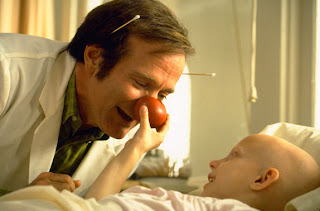Because we are Halloween masochists, my friends and I drove out to the Lancaster area for Field of Screams, which can be best described as a horror-movie-set-haunted-house on steroids. Sprinting from room to room offers a completely new, dizzying experience, with different themes and scary people to touch you or chase you down with chainsaws.
But this one room. This one room was unlike any other...
It zigzagged. The walls were tiled with 2x2" black and white checkers. There was a strobe light. I was holding my friend's hand and trying to keep my eyes shut through the flickering.
Out of nowhere, sitting in the corner, tiny and dejected, was this freaking clown. It looked so far away. Then suddenly, not one second later, it was IN MY FACE. The strobe light betrayed my perception of its speed and distance. I cried out. Please, just take me now, and do it quickly...
Hence my newfound coulrophobia, or fear of clowns.
But is coulrophobia a real fear? And, for that matter, what is fear?
Fear: a primer
A woman—known simply in the neuroscience world as S.M.—walked through a park alone one night and was attacked by man with a knife. Terrifying.
Except she walked through the same park again the very next day.
S.M. not only doesn't feel fear—she doesn't understand it. When researchers asked her to sketch out the six basic emotions, she drew the following:
They're detailed, insightful, even charming pictures—eyebrows furrowed just right, facial wrinkles conformed to the perfect expression, and...a baby's body for "afraid."
S.M. has an extremely rare recessive genetic disorder called Urbach-Wiethe disease, or lipoid proteinosis. The symptoms vary greatly, from hoarse voice to dry skin to scarring. But what affects S.M.'s ability to understand fear is her damaged amygdala.
The amygdala, Greek for "almond," is a pair of structures deep within the medial temporal lobes in our brains (shown in green). We know that the amygdala is involved in fear because of animal lesion studies. Mice or rats that receive lesions (damage) to this area have difficulty learning fear; while normal animals may learn to avoid a certain region in their cage that causes a shock to their foot, those with lesioned amygdalas will continue to visit the area—even though they feel the unpleasant sensation just as much as the normal animals.
In Urbach-Wiethe patients, calcium deposits build up in the blood vessels in this region, causing them to harden and eventually kill off the surrounding tissue. S.M.'s amygdala is nonfunctional—and so is her ability to fear.
Don't send in the clowns
In 2008, Nursing Standard magazine and BBC reported the results of a University of Sheffield study: kids hate clowns.
Researchers surveyed over 250 children, aged four to 16, and found clowns to be "universally disliked" by all ages. Said Penny Curtis, "Some found the clown images to be quite frightening and unknowable."
The poll was aimed at improving hospital decor for the children. Needless to say, Patch Adams won't be making any pit stops at the University of Sheffield hospital anytime soon.
Coulrophobia is indeed considered in the DSM-IV (Diagnostic and Statistical Manual of Mental Disorders, fourth edition)—the Bible of the psychiatry world. It's encompassed under "specific phobia," code 300.29.
Psychologists believe that this kind of fear may have less to do with clowns and more with the unsettling familiarity. A normal-sized body with a painted face, big shoes, colorful clothes—but what's under there?
"People are typically frightened by things which are wrong in some way, wrong in a disturbingly unfamiliar way," says Paul Salkovskis of the Maudsley Hospital Centre for Anxiety Disorders and Trauma in London.
Anthropologists may approach the phobia from the clown's perspective. In 1961, Claude Levi Strauss wrote about the "freedoms" that masking oneself allows. A mask gives a clown the chance to adopt a new identity: "the facial disguise," he writes, "temporarily eliminate[s] from social intercourse that part of the body which...the individual's personal feelings and attitudes are revealed or can be deliberately communicated to others."
Whether you're trying to redesign a hospital ward or just get through Halloween despite your fear of Bobo, don't be ashamed of coulrophobia.
In fact, if you're like my mother and hate Halloween, look ahead to Thanksgiving—and be thankful for your intact amygdala that allows you to be fearful in the first place!
Adolphs, R. (1997). Fear and the human amygdala Neurocase, 3 (4), 267-274 DOI: 10.1093/neucas/3.4.267
Levi-Strauss, C. (1961). The Many Faces of Man. World Theatre, 10, 3-61.






Very nice, Jordan! I've read that some people also have perhaps a similar sort of fear: humanoid face with cat-like features, as sometimes seen in Japanese animes. I presume, this fear also falls under the "unsettling familiarity" group. Perhaps you can tackle this in a forthcoming blog post ;)
ReplyDeleteI've wondered if part of the issue we have with clowns is that from a distance, we see one facial expression (painted on), but when we get close, we see a different facial expression (that of the face itself). We learn that clowns cannot be trusted.
ReplyDeleteSue, that's a very interesting idea. Tricksters like clowns are not to be trusted, and the fact that it's confirmed by their facial expression probably adds to that.
Deletegreat blog!
ReplyDelete